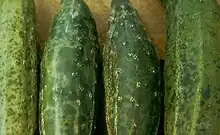| Cucumovirus | |
|---|---|
 | |
| Cucumber mosaic virus symptoms | |
| Virus classification | |
| (unranked): | Virus |
| Realm: | Riboviria |
| Kingdom: | Orthornavirae |
| Phylum: | Kitrinoviricota |
| Class: | Alsuviricetes |
| Order: | Martellivirales |
| Family: | Bromoviridae |
| Genus: | Cucumovirus |
| Species[1][2] | |
| |
Cucumovirus is a genus of viruses, in the family Bromoviridae.[3] Plants serve as natural hosts. There are four species in this genus.[1][4]
Taxonomy
The following species are assigned to the genus:[2]
- Cucumber mosaic virus
- Gayfeather mild mottle virus
- Peanut stunt virus
- Tomato aspermy virus
Structure
Viruses in the genus Cucumovirus are non-enveloped, with icosahedral and Spherical geometries, and T=3 symmetry. The diameter is around 29 nm. Genomes are linear and segmented, tripartite.[1][4]
| Genus | Structure | Symmetry | Capsid | Genomic arrangement | Genomic segmentation |
|---|---|---|---|---|---|
| Cucumovirus | Icosahedral | T=3 | Non-enveloped | Linear | Segmented |
Life cycle
Viral replication is cytoplasmic. Entry into the host cell is achieved by penetration into the host cell. Replication follows the positive stranded RNA virus replication model. Positive stranded rna virus transcription, using the internal initiation model of subgenomic rna transcription is the method of transcription. The virus exits the host cell by tubule-guided viral movement. Plants serve as the natural host. Transmission routes are mechanical and contact.[1][4]
| Genus | Host details | Tissue tropism | Entry details | Release details | Replication site | Assembly site | Transmission |
|---|---|---|---|---|---|---|---|
| Cucumovirus | Plants | None | Viral movement; mechanical inoculation | Viral movement | Cytoplasm | Cytoplasm | Mechanical inoculation: insects; contact |
Epidemiology
It is thought that cucumoviruses are present worldwide, being known to occur in Eurasia, Australia, Canada, France, India, Japan, North and South Korea, Morocco, New Zealand, Poland, Spain, the US, and the former USSR. Its natural hosts belong to the domain Eukaryota. The virus is transmitted by vector, mechanical inoculation, grafting, or seeds, and it is transmitted in a non-persistent manner. The vectors may be arthropods, specifically insects of the order Hemiptera, family Aphididae (colloquially one would say cucumovirus is transmitted by aphids).[1]
References
- 1 2 3 4 5 "ICTV Report Bromoviridae".
- 1 2 "Virus Taxonomy: 2020 Release". International Committee on Taxonomy of Viruses (ICTV). March 2021. Retrieved 14 May 2021.
- ↑ Bujarski, J; Gallitelli, D; García-Arenal, F; Pallás, V; Palukaitis, P; Reddy, MK; Wang, A; ICTV Report, Consortium (August 2019). "ICTV Virus Taxonomy Profile: Bromoviridae". The Journal of General Virology. 100 (8): 1206–1207. doi:10.1099/jgv.0.001282. hdl:11586/301641. PMID 31192783.
- 1 2 3 "Viral Zone". ExPASy. Retrieved 15 June 2015.